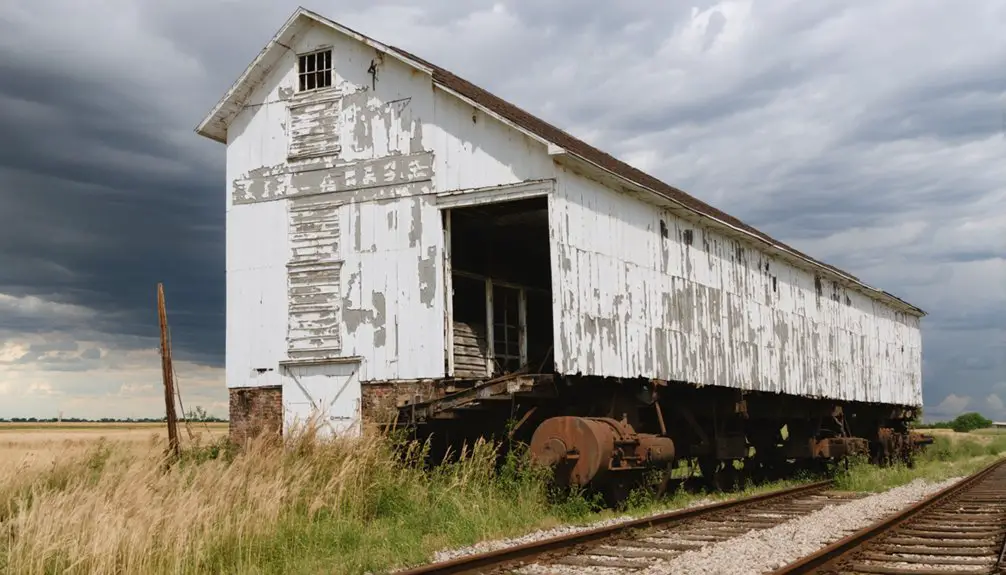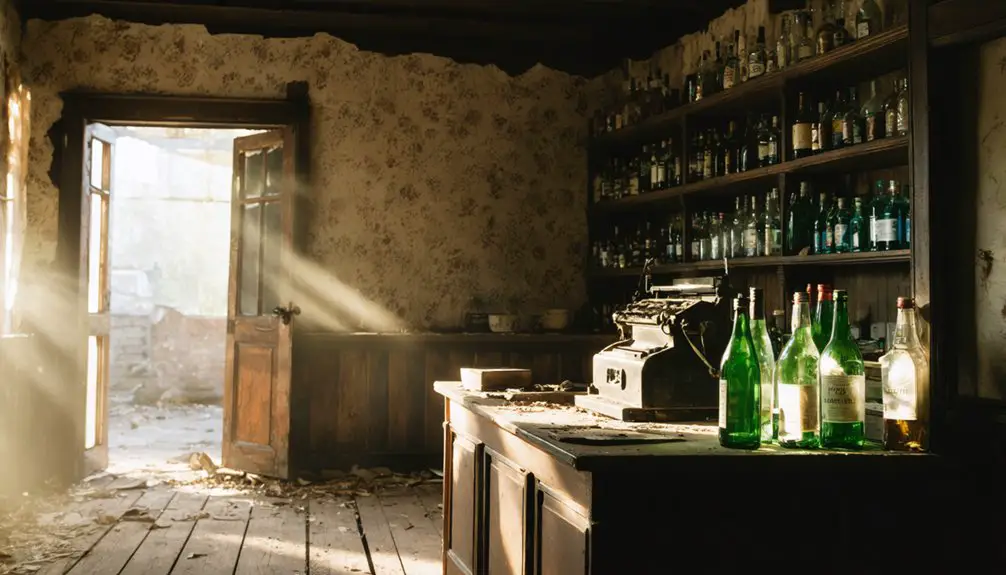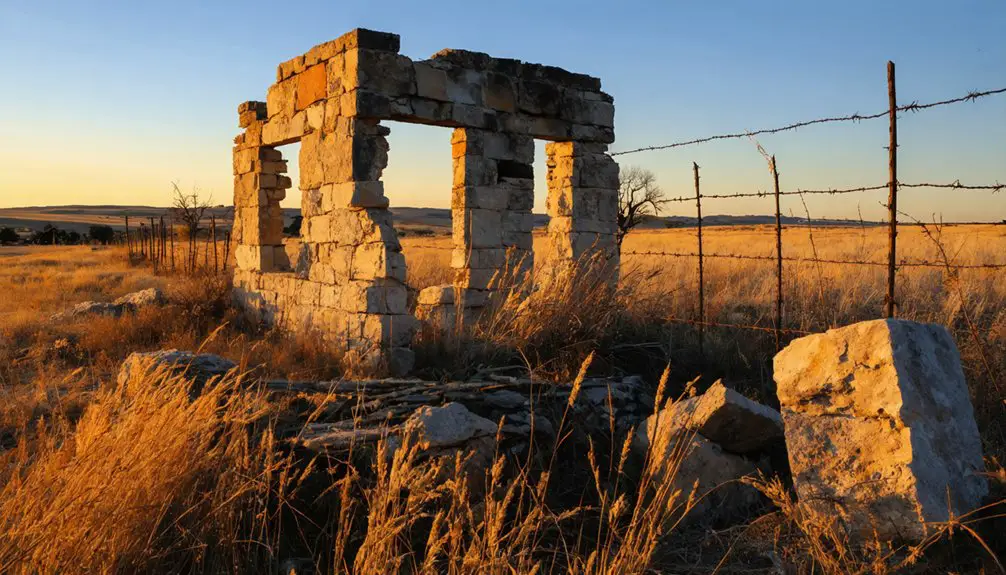You’ll find Shaffer as a ghost town in Cloud County, Kansas, where pioneer George Shaffer first settled in 1867. He endured five years of solitude while establishing the area’s first homestead in Benton township, facing harsh weather and total isolation. The town later grew into a vibrant farming community with limestone buildings, a church, and the First National Bank, but agricultural modernization and shifting transportation routes led to its decline. Its remaining structures tell a compelling story of pioneer perseverance.
Key Takeaways
- Shaffer emerged from George Shafer’s 1867 pioneer settlement in Cloud County, Kansas, developing into a small but vibrant farming community.
- The town featured essential structures including a schoolhouse, Holy Trinity Catholic Church, post office, and First National Bank.
- Agricultural modernization and farm consolidation in the early 20th century led to population decline and business closures.
- Transportation changes, including railroad routes and highways bypassing Shaffer, contributed to the town’s economic isolation.
- Limestone buildings remain as architectural remnants, with the pioneer schoolhouse converted to a library preserving educational heritage.
Pioneer Origins and Early Settlement
When George Shafer arrived in Cloud County during the autumn of 1867, he joined a wave of pioneers who’d face the challenging Kansas frontier. Like many settlers, his pioneer motivations led him to brave uncertain conditions in search of opportunity and independence.
Settlement challenges were abundant across Kansas in those early years. You’d find wagon routes diverted by rough terrain and unreliable water sources, especially in places like Smith County. These pioneering conditions were similar to what U.S. Army scouts encountered while serving at various Texas forts in the 1850s.
Townsite companies often redirected settlers to more viable locations, understanding the crucial balance between survival and growth. Early outposts like Maxwell’s Ranch emerged as essential hubs, serving as cavalry headquarters and meeting grounds for diverse frontier populations. The ranch became renowned for Maxwell’s silver service, which he used to entertain countless travelers passing through.
These settlement centers provided necessary supplies, safety, and social connections for pioneers establishing their stake in the untamed Kansas prairie.
The Story of Mr. Shaffer’s Solitary Years
You’ll discover Mr. Shaffer’s remarkable five-year solitude as the first pioneer of Benton township, where he faced the raw challenges of frontier life completely alone.
His determination through harsh weather, limited supplies, and total isolation helped establish the groundwork for future settlement in the area. Much like the pioneers of Presidio Mining Company, his resourcefulness laid foundations for growth.
The daily struggles of maintaining his homestead while managing everything from farming to shelter-building became an inspiring demonstration of the pioneering spirit that shaped early Kansas communities. Like many early Kansas settlers, he endured devastating grasshopper invasions that threatened his survival.
Pioneer Life Challenges
Life on the Kansas frontier tested Mr. Shaffer’s pioneer resilience daily, as he faced the raw challenges of homesteading alone. The solitude impacts of managing his remote ranch meant handling every vital task independently, from securing water to protecting his prized Hereford cattle. Similar to John Charles Shaffer who later established Ken-Caryl Ranch, he understood the importance of building a lasting legacy through his land. Like the historic frame construction of the Schaefer mansion that withstood fierce windstorms, his determination proved equally resilient against nature’s forces.
You’d find the pioneer’s determination reflected in:
- Battling harsh elements while maintaining basic shelter and infrastructure
- Staying vigilant against wildlife threats and potential tribal conflicts
- Managing livestock operations without regular support or assistance
- Sourcing essential supplies through treacherous terrain and weather
Despite these hardships, Shaffer’s commitment to building his legacy drove him forward. He embraced self-sufficiency, developing strategic systems for ranch operations and establishing trade relationships with neighboring settlers when possible, all while enduring the psychological weight of isolation.
Impact on Early Settlement
As one of the first Volga German settlers in 1876, Mr. Shaffer’s solitary years laid the foundation for what would become a thriving Kansas settlement.
Similar to trading activities in Central City, the settlement established vital commerce networks with neighboring communities.
You’ll find his influence in the limestone structures that emerged from the initial dugouts along Big Timber Creek, marking a significant shift toward cultural continuity from their Russian homeland.
His early work established essential patterns for the community’s architectural significance, from quarrying techniques to the distinctive positioning of doors facing away from streets.
During those lonely winters, he helped shape the village’s physical character, drawing from traditional building methods while adapting to Kansas’ harsh frontier conditions.
The settlement’s eventual organization around a central church reflected the strong religious values and communal bonds that would define this Volga German community. Following the example of nearby Liebenthal’s 1878 church, this spiritual center became a cornerstone of their cultural identity.
Life in Early 20th Century Shaffer
During the early 20th century, Shaffer emerged as a vibrant farming community near Hays, Kansas, where settlers like Henry D. Shaffer owned vast tracts of farmland.
Cultural customs shaped daily life, while economic diversity flourished through agriculture, lumber, and trading ventures. Local architect George W. Shaffer contributed to the region’s development through his architectural work. The town’s growth was marked by the construction of the First National Bank in 1888.
If you’d visited Shaffer back then, you would’ve experienced:
- Bustling ranches like Maxwell’s, where travelers gathered around elaborate table settings and enjoyed renowned hospitality.
- Mixed labor forces working the fields, with Native Americans and Mexicans contributing to the community’s growth.
- Social gatherings that strictly observed gender separation in domestic spaces.
- Thriving businesses run by merchants like R.M. Shaffer, who dealt in coal and grain.
You’d have found a community where veterans led civic engagement and public education served local children through rural schoolhouses.
The Rise and Fall of Shaffer School
The original Shaffer Seventh-day Adventist School opened its doors in 1894, breathing life into a small church building northwest of Shaffer, Rush County.
You’d have witnessed its educational evolution from a simple one-room schoolhouse to a progressive two-room facility by 1908, when the congregation built a dedicated school building to meet growing needs.
The school’s design reflected modern standards from the Hays Normal School, featuring optimized window placement and ventilation.
Through decades of community engagement, you’d find students advancing through up to 10 grades, far more than typical rural schools offered.
But like many rural institutions, Shaffer School couldn’t escape the winds of change.
Agricultural Heritage and Economic Base

While early settlers like S. Shaffer built their livelihoods on traditional farming and livestock operations, you’ll find that agricultural innovation transformed this once-thriving community.
The march of mechanization brought dramatic changes to Shaffer’s economic foundation, altering the very fabric of rural life.
You can trace the community’s decline through these key agricultural shifts:
- Large-scale mechanized farming replaced labor-intensive methods
- Hybrid seeds and irrigation systems favored bigger operations
- Farm consolidation absorbed smaller family homesteads
- Economic diversification failed as businesses relocated to larger towns
What you’re seeing in Shaffer mirrors a broader pattern across Kansas, where agricultural modernization paradoxically led to rural decline.
As farms grew larger but fewer, the population dwindled, taking with it the shops, schools, and services that once made this prairie town pulse with life.
Population Decline Through the Decades
As Kansas towns flourished in the late 1800s, Shaffer’s population trends remained largely undocumented, though you’ll find its story mirrors countless other rural communities across the state.
Like many small towns, Shaffer faced significant demographic changes throughout the 20th century, driven by shifting economic realities and broader societal transformations.
You can trace the population shifts through familiar patterns: the decline of local industries, changes in farming practices that required fewer workers, and the magnetic pull of bigger cities offering more opportunities.
While specific numbers aren’t available for Shaffer, the town’s eventual ghost town status tells a common tale of rural decline.
Natural disasters, economic downturns, and the lack of modern infrastructure all contributed to the steady exodus of residents until the town faded into history.
Impact of Regional Transportation Changes

Transportation networks shaped Shaffer’s destiny more profoundly than perhaps any other factor in its history. The transportation evolution that swept through Kansas brought dramatic economic transformation, leaving Shaffer increasingly isolated.
Transportation’s evolving networks reshaped Kansas’s landscape, sealing Shaffer’s isolation through dramatic economic shifts and dwindling connections.
You can still trace the town’s decline through these crucial changes:
- The railroad’s arrival in neighboring towns diverted essential commerce away from Shaffer’s once-bustling wagon routes.
- Early 20th-century highways bypassed the settlement, redirecting travelers and trade elsewhere.
- Farm goods and supplies found faster routes through rail hubs, diminishing Shaffer’s local markets.
- Deteriorating local roads discouraged visitors and gradually cut off remaining business connections.
Without key transportation links, Shaffer’s role as a regional hub faded. The town’s political influence waned, investment dwindled, and its fate as a ghost town was sealed by these shifting transportation patterns.
Remaining Architecture and Buildings
You’ll find one of Shaffer’s most notable surviving structures in the pioneer schoolhouse, which now serves as the town’s library and stands as a symbol of the community’s educational heritage.
The building’s limestone construction, typical of early Kansas architecture, has helped it withstand decades of harsh prairie weather and abandonment that claimed many other structures.
While most of Shaffer’s original homes lie in various states of decay, their weathered frames and exposed foundations offer glimpses into the town’s residential past, complete with period features like storm cellars and original woodwork.
Pioneer School Turned Library
Limited historical records exist regarding the pioneer school that was later converted into a library in Shaffer, Kansas.
While the exact timeline of this transformation isn’t documented, the building’s evolution from schoolhouse to library represents an important piece of the town’s educational significance and library history.
When you visit the former pioneer school, you’ll find a structure that served multiple community purposes over time:
- A place where local children once gathered for their daily lessons
- A reflection of the community’s commitment to education and literacy
- A building that adapted to changing needs by becoming a library
- A symbol of how rural communities preserved their educational heritage
The details of the building’s architecture, collections, and operational history haven’t been preserved in available records, though its transformation reflects the resourcefulness of frontier towns.
Historical Residential Structures
While many Kansas ghost towns have vanished entirely, Shaffer’s residential structures offer glimpses into frontier life through their weathered facades and architectural remnants.
You’ll find timber-frame houses with simple gabled roofs and symmetrical fronts that characterize the region’s prairie vernacular style. Despite minimal historic preservation efforts, these homes still showcase the practical design elements that helped settlers endure Kansas’s harsh climate, including storm cellars and root cellars.
The properties tell stories of self-sufficient living, with remnants of vegetable gardens, fruit trees, and nearby outbuildings like barns and storage sheds.
Though most structures now display significant decay, with peeling paint and sagging foundations, their architectural styles reflect the modest yet resilient spirit of frontier families who built their lives around railroad lines and agricultural dreams.
Community Life and Social Changes

As Shaffer established itself in southeastern Rush County during the late 19th century, the community initially flourished with the essential components of small-town Kansas life.
The post office and Holy Trinity Catholic Church served as anchors for community gatherings and social institutions, creating bonds among residents.
Two pillars of rural life – the post office and church – wove together the social fabric of Shaffer’s close-knit community.
You would have experienced these defining elements of Shaffer’s peak era:
- Regular postal services connecting families to the outside world
- Sunday church services bringing neighbors together in fellowship
- Railroad activity bustling with grain and livestock shipments
- Local merchants serving daily needs of farming families
Present-Day Shaffer and Its Legacy
Today’s visitors to Shaffer encounter a quiet memorial to Kansas’ rural past, where abandoned early 20th-century buildings stand as silent witnesses to a once-thriving community.
As a ghost town with minimal remaining residents, Shaffer’s structures from the 1920s now weather the elements with little maintenance beyond occasional volunteer efforts.
You’ll find this remote settlement’s cultural significance lies in its representation of Great Plains depopulation after railroad stops vanished.
While tourism remains limited due to the town’s isolation and lack of infrastructure, Shaffer’s legacy endures as a symbol of the broader story of agricultural communities that once dotted western Kansas.
Though preservation efforts remain informal, the town continues to spark interest among historians and serves as a poignant reminder of the region’s evolving landscape.
Frequently Asked Questions
What Natural Disasters or Severe Weather Events Has Shaffer Endured?
A million storms tore through your plains, with devastating tornado impacts hammering buildings and crops. You’d face brutal flooding that crippled recovery efforts, while grasshopper plagues and fires ravaged your community.
Were There Any Notable Crimes or Lawlessness in Shaffer’s History?
You’ll find limited records of specific crime incidents in the area, though nearby towns had typical frontier lawlessness. Law enforcement reports from Sumner County show occasional violent crimes persisted in rural regions.
What Native American Tribes Originally Inhabited the Shaffer Area?
In summary, the Kanza and Osage tribes called this land home. You’ll find their historical influence through the region, where they hunted buffalo and established seasonal camps.
Did Shaffer Have Any Connection to the Underground Railroad?
While you won’t find direct evidence of Shaffer’s Underground Railroad connections, it’s located in an area where free-state settlers and abolitionists were active in helping freedom seekers escape to safety during those historic times.
What Role Did Women Play in Shaffer’s Development and Leadership?
You’d be amazed – women moved mountains through their leadership roles! Women’s contributions included establishing churches, running schools, managing households, providing healthcare, and creating social stability through community organizations.
References
- https://www.legendsofamerica.com/shafter-texas/
- https://www.youtube.com/watch?v=VPZtNoncnig
- https://www.ksgenweb.org/archives/butler/history/1916/33/s/shaffer_s.html
- https://www.youtube.com/watch?v=alC1wDdSVvg
- https://en.wikipedia.org/wiki/List_of_ghost_towns_in_Kansas
- https://hchm.org/from-gettysburg-to-sedgwick-the-adventures-of-charles-schaefer-part-2/
- https://hchm.org/tag/charles-schaefer/
- https://usgenealogyresearch.atwebpages.com/Kansas/Smith/misc_Smith County KS History of Smith Center 1871-1971.pdf
- https://soar.wichita.edu/bitstreams/e5a86af9-afe5-446a-aafe-af0595f16000/download
- https://www.ksgenweb.org/archives/cloud/1903/shaferg.html



